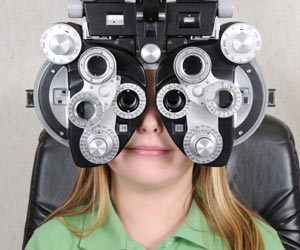InfantSEE®
InfantSEE®, a public health program, managed by Optometry Cares® – the AOA Foundation, is designed to ensure that eye and vision care becomes an essential part of infant wellness care to improve a child’s quality of life. Under this program, participating optometrists provide a comprehensive infant eye assessment between 6 and 12 months of age as a no-cost public service. Click here to learn more and locate a doctor in your area who can provide the free infant assessment.
Even if no eye or vision problems are apparent, the American Optometric Association recommends scheduling your baby’s first eye assessment at 6 months. Things that the Optometrist will test for include:
- excessive or unequal amounts of nearsightedness, farsightedness, or astigmatism
- eye movement ability
- eye health problems
These problems are not common, but it is important to identify children who have them at this young age. Vision development and eye health problems are easier to correct if treatment begins early. Here is the info on children exams. We are happy to see children of all ages for eye examinations!
Eye Exams for Children
As a parent, you may wonder whether your pre-schooler has a vision problem or when a first eye exam should be scheduled. Eye exams for children are extremely important. Experts say 5 percent-10 percent of pre-schoolers and 25 percent of school-aged children have vision problems. Early identification of a child’s vision problem is crucial because, if left untreated, some childhood vision problems can cause permanent vision loss.
When should kids have their eyes examined?
According to the American Optometric Association (AOA), infants should have their first comprehensive eye exam at 6 months of age. Children then should receive additional eye exams at 3 years of age, and just before they enter kindergarten or the first grade at about age 5 or 6.
For school-aged children, the AOA recommends an eye exam every two years if no vision correction is required. Children who need eyeglasses or contact lenses should be examined annually or according to their eye doctor’s recommendations. Early eye exams also are important because children need the following basic visual skills for learning:
- Near vision
- Distance vision
- Eye teaming (binocularity) skills
- Eye movement skills
- Focusing skills
- Peripheral awareness
- Eye/hand coordination
Because of the importance of good vision for learning, some states require an eye exam for all children entering school for the first time.
Scheduling your child’s eye exam
Your family doctor or pediatrician likely will be the first medical professional to examine your child’s eyes. If eye problems are suspected during routine physical examinations, a referral might be made to an ophthalmologist or optometrist for further evaluation. Eye doctors have specific equipment and training to help them detect and diagnose potential vision problems.
When scheduling an eye exam, choose a time when your child is usually alert and happy. Specifics of how eye exams are conducted depend on your child’s age, but an exam generally will involve a case history, vision testing, determination of whether eyeglasses are needed, testing of eye alignment, an eye health examination and a consultation with you regarding the findings.
After you’ve made the appointment, you may be sent a case history form by mail, or you may be given one when you check in at the doctor’s office. The case history form will ask about your child’s birth history (also called perinatal history), such as birth weight and whether or not the child was full-term. Your eye doctor also may ask whether complications occurred during the pregnancy or delivery. The form will also inquire about your child’s medical history, including current medications and past or present allergies.
Be sure to tell your eye doctor if your child has a history of prematurity, has delayed motor development, engages in frequent eye rubbing, blinks excessively, fails to maintain eye contact, cannot seem to maintain a gaze (fixation) while looking at objects, has poor eye tracking skills or has failed a pediatrician or pre-school vision screening.
Your eye doctor will also want to know about previous ocular diagnoses and treatments involving your child, such as possible surgeries and glasses or contact lens wear. Be sure you inform your eye doctor if there is a family history of eye problems requiring vision correction, such as nearsightedness or farsightedness, misaligned eyes (strabismus) or amblyopia (“lazy eye”).